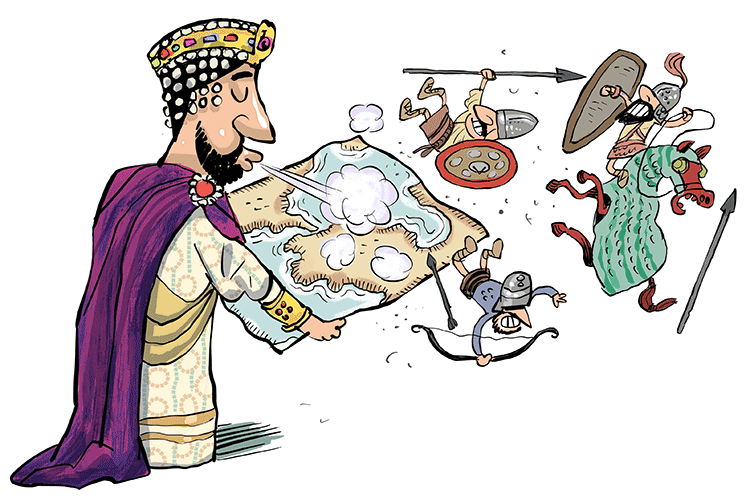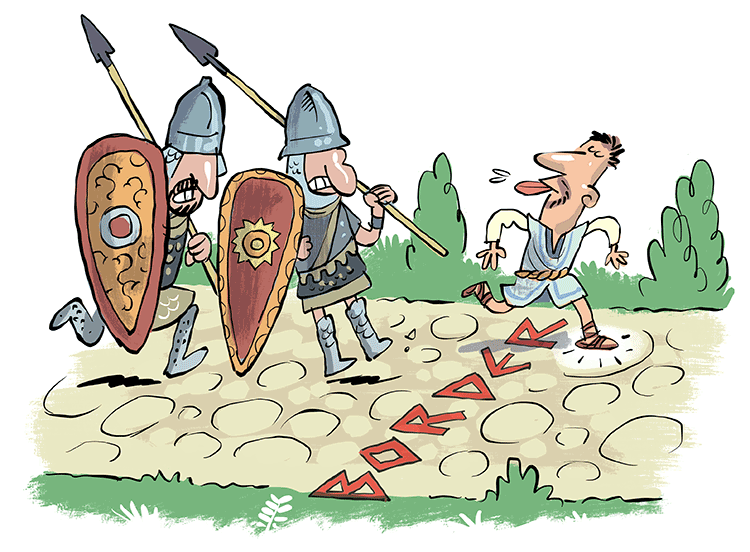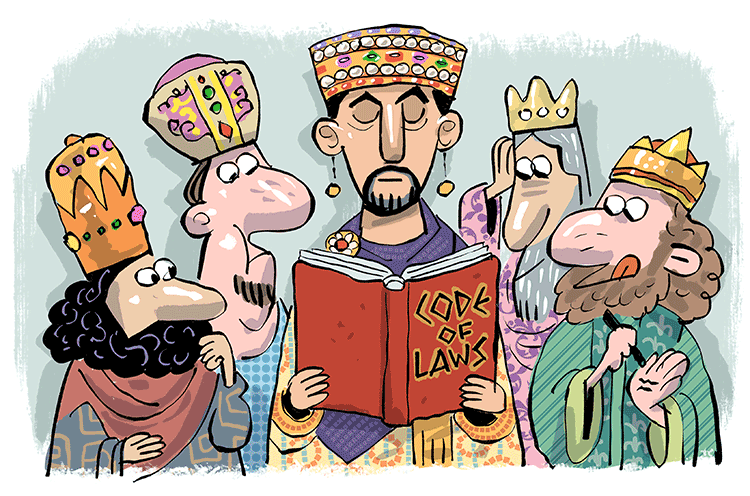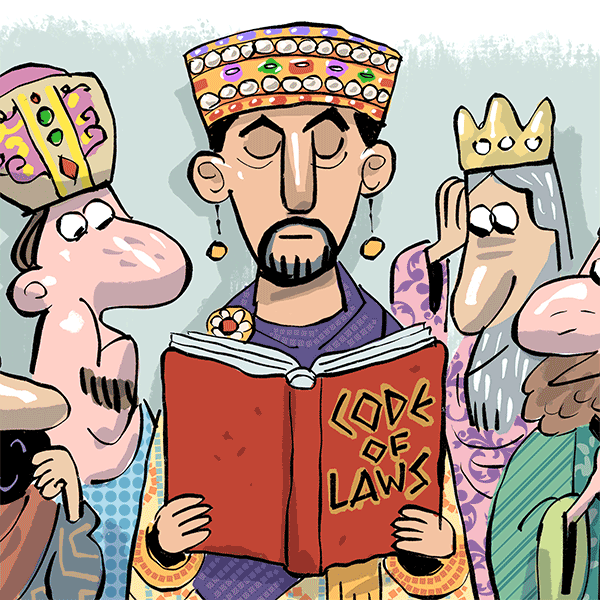From our modern perspective, the past often feels like a lawless time. Because nations were less organized and war was more frequent, it’s easy to look back and think no one was in charge.
But this isn’t really true. Law was still an important part of Medieval life. It was just really, really confusing.
This changed thanks to the Byzantine Empire. More specifically, it changed because of a man named Justinian I and his Corpus Juris Civilis, which translates to “body of civil law.”
Sounds fancy, no? Well, it kind of is.
This book, or collection of books, totally transformed how we understand and practice law.
Kind of a big deal.
All in all, Justinian I himself was kind of a big deal. On top of his contribution to law, his time as emperor was the most significant in the 1,000 year history of Byzantium.
So what makes him so special?

Bringing Byzantium to its Territorial Peak
Although Justinian I was known for his laws, he did a lot of other things. For one, he took a lot of land from his neighbors. Most of these conquests were into Europe, lands once held by Rome.
He didn’t like it that he ruled the “Roman” empire but didn’t control “Rome” itself. So he started marching east.
Along the way, he ran into the Sassanids.
This dynasty, which occupied much of modern-day Iran as well as Mesopotamia, was the third generation of Persian rulers to control a significant empire. Though they never had an empire the size of their predecessors, the Sassanids were a major thorn in the side of both the Roman and Byzantine Empires.
War with the Sassanids was already underway when Justinian I took power in 527 AD, but he finished things off.
This brought large sections of Mesopotamia and modern-day Syria back under Byzantine control.
From there, he went west, campaigning first in North Africa, then Italy, and later Hispania, which we now know as the Iberian peninsula.
Taking Back Italy
By 554 AD, he had managed to conquer nearly all the land he set out to take. The effect of this has been debated. It was an enormously costly campaign, both in terms of gold and human life. But the symbolic victory was hard to ignore.
For the first time in over 100 years, Italy, the birthplace of the Roman empire, was back under the control of Romans.
Well, sort of.
Remember that the name “Byzantine empire” is the one we use. People living in the empire at the time referred to themselves as Romans and subjects of the Roman empire, even though Rome was no longer the capital or even part of the empire.
No matter how you look at it, though, Justinian I’s efforts brought the Byzantine empire to its territorial peak. This greatly expanded the tax base and allowed him to commission splendid works of art and architecture, the most famous being the Hagia Sophia.
Originally built as a Christian church, the Hagia Sofia is now a Muslim mosque and one of the most well-known attractions in the modern-day city of Istanbul.
Justinian’s artistic endeavors helped spur a bit of a renaissance in the Byzantine empire, reconnecting lands as far west as England to what used to be the Roman empire.
Thanks largely to this, Justinian was later enshrined as a saint in the Eastern Orthodox Church.
Not a bad job as an emperor. Not bad at all.
A Final Breath for the Western Roman Empire
While Justinian’s conquests helped improve the legacy of the Byzantine empire, they can also be viewed as a reminder that western Europe desperately missed the influence of a powerful central authority that had once been provided by the city of Rome.
After the fall of the Western Roman Empire, trade had suffered immensely. Roads fell into disrepair, and people fled for the countryside in fear of raids conducted by any number of Germanic tribes.
The successful invasions of Justinian I temporarily restored the peace and order western Europe had enjoyed under the Romans, as well as the economic prosperity that came with it.
But Justinian’s conquests in western Europe were short-lived.
Soon after his death, the many kingdoms competing for dominance in western Europe once again broke up imperial control. Just like Rome struggled to fully unite both its eastern and western territories, Byzantium did too. The empire lived on in the east, but Western Europe had to say goodbye to a unified and centralized government.
All parties must end, sadly.
But this brief period of unity speaks once again to the enduring impact of Rome.
A few hundred years later, Europe would try again to unite, using the name “Holy Roman Empire.” Though this too was short-lived, the very name, “Holy Roman,” speaks to the ideal that Rome was to the people of that time.
Whether or not that ideal reflected reality is not entirely important. Maybe people were just holding onto the past? It can be hard to let go sometimes.
Today, this spirit still lives. The European Union helps facilitate trade and other important activities that bring the vast cultures of Europe together and encourage cooperation. Though nothing like an empire, the idea behind it is very similar to the one which has motivated Europe for 2,000 or more years.

The Justinian Code of Laws
While Justinian I was all about territorial conquest and restoring the glory of Rome in Western Europe, he didn’t stop there. He went on to establish a Code of Laws that would redefine the legal world for centuries to come.
Again, he was quite a big deal.
Justinian I was so concerned with laws because when he took over as Byzantine emperor, the legal system across Europe was a big giant mess.
What was legal in one place was illegal in another. Punishments were different in different lands, no matter if the crime was the same. And certain activities governed by laws in a given area were not monitored in another.
It was pure chaos.
Besides giving medieval lawyers a major headache, this also made it more difficult for any central authority to truly assert itself.
After all, if it tried to punish someone, they could often escape consequence by traveling just a few miles down the road to be in a different territory. It’s sort of like when mom says no and then you ask dad and he says yes. Works out for you, but it makes it much harder for mom to stand as an authority.
Creating the Code
So, what did Justinian do? He hired a team of lawyers and scribes to collect all the laws in use across his empire, compile them into one document, and standardize them so that there would be less confusion. He also had them collect as much information as possible on the various court cases and legal interpretations out there so that he could put them all in one spot.
This was an enormous undertaking — it took more than a decade to complete — but once finished, it had a profound impact on people living inside and outside the empire’s territorial limits.

Forming the Basis of Modern International Law
Many of the kingdoms operating in Western Europe outside of Byzantine control began using the Code to help settle legal matters with other kings and political entities.
They were saying, “Hey, this is pretty useful! We don’t have to keep making things up all the time!”
Also, even if these kingdoms were not Roman, highlighting a connection to Rome helped establish legitimacy. And who doesn’t like legitimacy!?
You see, using the Code meant referring to some higher authority, and this made it easier for the various authorities across Europe to deal with their legal problems. There is even evidence of kingdoms in England, which were far outside of Byzantine control, using the code to draft laws, suggesting this was an idea with tremendous appeal.
Of course, it wasn’t perfect. People obviously contested the Code or disregarded it, but its very existence gave birth to the idea of international law. It also introduced the idea that a state, to be able to function properly, needs a centralized code of laws to use as a reference point.
Need an example? The US constitution could be one. Or how about the European charter that governs the EU? Need more? Think about every constitution in every country in the world…
International law is still a fuzzy subject. Modern civilization has created a framework for it, but enforcing it is a whole different challenge. Nevertheless, it remains an attractive idea, and its roots can be found in the Justinian Code created more than 1,500 years ago.
Byzantium’s Most Famous Ruler
Between his territorial conquests that brought Italy back under Roman control for the final time, and his legendary code of laws, Justinian was, like we’ve said, actually a pretty big deal. In fact, no other Byzantine emperor would come close to matching his achievements.
So, if there was an MVP award to give out to Byzantine rulers, Justinian I, aka Saint Justinian, wins in unanimous fashion.
Written by Matthew Jones
Illustrated by Jean Galvao
